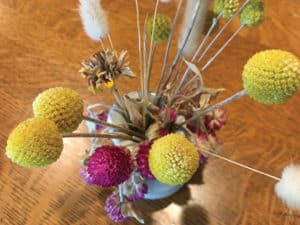By Bonnie Kirn Donahue, extension master gardener — University of Vermont
Summer can feel fleeting. Drying flowers is a great way to hold onto its essence.
Flowers that work well for drying should have either nice color, texture, structure or a combination when dried. It is also important that you find the flower appealing. The most important characteristic is that they maintain a strong structure after being dried.

Dried sunballs, bunny tails and globe ama- ranth can be combined to create a simple, eye- catching mixed dried flower arrangement.
Many types of flowers work well for drying. Perennials and shrubs with large blooms such as peonies (Paeonia spp.), roses (Rosa spp.) and hydrangeas (Hydrangea spp.) dry very similar to their fresh shapes.
Great dried annual flowers include plants such as sunballs (Craspedia globosa), globe amaranth (Gomphrena globosa), bunny tails (Lagurus ovatus), statice (Limonium sinuatum) and strawflower (Bracteantha bracteata).
Perennials that work well for drying include many ornamental grasses, lavender (Lavandula spp.) and globe thistle (Echinops ritro).
Another idea is to use dried seed pods from poppies (Papaver spp.), globe allium (Allium “globemaster”), sensitive fern (Onoclea sensibilis) or blue-flag iris (Iris versicolor), among others.
To start, select healthy plants that are free of disease, fungus or decay. Pick flower heads that are at peak or almost fully in bloom. Using flowers that are past peak bloom may not have the same visual impact as flowers picked just before.
There are several techniques for drying flowers. The way that I like to dry flowers is to hang them upside down from a string. I try to cut the flower with 6 to 10 inches of stem, and tie or wrap the string around the stem.
For peonies and other larger flowers, you will want to dry the stems individually. For smaller, thinner flowers on stalks, such as lavender or ornamental grasses, you can make small bundles and secure with rubber bands, and dry them in a group.
Depending on your preferences, you may want to remove any unwanted foliage before drying your flowers.
Make sure to pick a space to dry the flowers that is warm, dry and has good airflow. Allow the flowers to dry until they do not show signs of moisture, about two to three weeks. Inspect your flowers before using and discard any that show signs of mold or decay.
You can use your flowers as decorations in floral arrangements in vases, incorporated into wreaths, layered into jars as visual potpourri or in endless craft projects.
The great thing about trying to dry flowers for the first time is that you don’t need to take it too seriously. Instead, cut a few stems of flowers you think might be nice and dry them. If you like the results, you can dry more the following year. You never know what might look nice dried.
If you’re looking for more information on types of flowers to dry, talk to your local greenhouse, or look at seed catalogues for lists of flowers for drying.
Want more information on other drying techniques? Check out cooperative extension resources online or books on drying flowers from your local library.
Here’s to making summer last a little bit longer with dried flowers.




